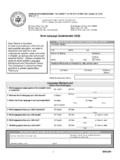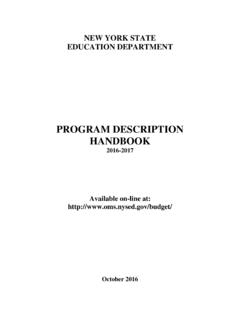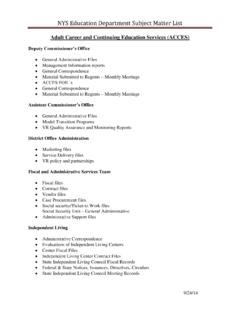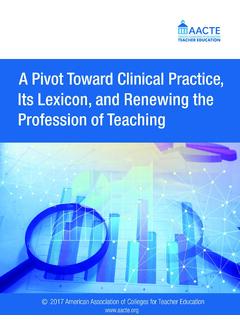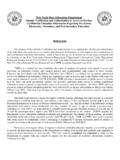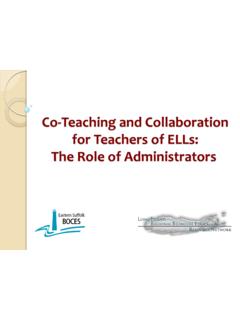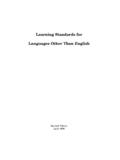Transcription of Physical Setting/Chemistry Core Curriculum
1 Physical Setting/ Physical Setting/ ChemistryChemistry Core Curriculum THE UNIVERSITY OF THE STATE OF NEW YORK THE STATE EDUCATION DEPARTMENT THE UNIVERSITY OF THE STATE OF NEW YORK Regents of The University CARL T. HAYDEN, Chancellor, , .. Elmira ADELAIDE L. SANFORD, Vice Chancellor, , , .. Hollis DIANE O NEILL MCGIVERN, , , .. Staten Island SAULB. COHEN, , , .. New Rochelle JAMES C. DAWSON, , , , .. Peru ROBERT M. BENNETT, , .. Tonawanda ROBERT M. JOHNSON, , .. Huntington ANTHONY S. BOTTAR, , .. North Syracuse MERRYL H. TISCH, , .. New York ENA L. FARLEY, , , .. Brockport GERALDINE D. CHAPEY, , , .. Belle Harbor ARNOLD B. GARDNER, , Buffalo CHARLOTTE K. FRANK, , , .. New York HARRY PHILLIPS, 3rd, , .. Hartsdale JOSEPH E. BOWMAN, JR., , , , , .. Albany LORRAINE A. CORT S-V ZQUEZ, , Bronx President of The University and Commissioner of Education RICHARD P. MILLS Chief Operating officer RICHARD H.
2 CATE Deputy Commissioner for Elementary, Middle, Secondary, and Continuing Education JAMES A. KADAMUS Assistant Commissioner for Curriculum , Instruction, and Assessment ROSEANNE DEFABIO Assistant Director for Curriculum and Instruction ANNE SCHIANO The State Education Department does not discriminate on the basis of age, color, religion, creed, dis ability, marital status, veteran status, national origin, race, gender, genetic predisposition or carrier sta tus, or sexual orientation in its educational programs, services, and activities. Portions of this publica tion can be made available in a variety of formats, including braille, large print or audio tape, upon request. Inquiries concerning this policy of nondiscrimination should be directed to the Department s Office for Diversity, Ethics, and Access, Room 152, Education Building, Albany, NY 12234. CONTENTS Acknowledgments ..iv Core Curriculum .
3 1 Introduction ..3 Process Skills Based on Standards 1, 2, 6, and 7 ..5 Process Skills Based on Standard 4 ..12 Standard 4: The Physical Setting ..16 Appendix A: Chemistry Core Topics ..26 Appendix B: Chemistry Content Connections Table ..34 Chemistry iii ACKNOWLEDGMENTS The State Education Department acknowledges the assistance of teachers and school administrators from across New York State and the New York State Chemistry Mentors. In particular, the State Education Department would like to thank: Robert Dayton Rush-Henrietta High School, Henrietta Mary Dery Dutchess BOCES, Poughkeepsie David Hanson SUNY at Stony Brook, Stony Brook Linda Hobart Finger Lakes Community College, Canandaigua Silvana Jaus Edgemont High School, Scarsdale Carol Jemmott Bishop Loughlin memorial High School, Brooklyn Elaine Jetty Ravena-Coeymans-Selkirk Senior High School Patrick Kavanah (retired) Monroe Woodbury Senior High School, Central Valley David Kiefer Midwood High School, Brooklyn Elise Hilf Levine Scarsdale High School, Scarsdale Joan Laredo-Liddell St.
4 Barnabas High School, Bronx June Kasuga Miller Queens College, Flushing Theresa Newkirk Saratoga Springs Sr. High School, Saratoga Springs Linda Padwa Port Jefferson High School, Port Jefferson Cynthia Partee Division High School, Levittown Diane Pillersdorf Richmond Hill High School, Richmond Hill Lee Roberts Wellsville High School, Wellsville Lance W. Rudiger Potsdam Senior High School, Potsdam David L. Shelc Portville High School, Portville Thomas Shiland Saratoga Springs Senior High School, Saratoga Springs Virginia M. Trombley AuSable Valley High School, Clintonville Alice Veyvoda Half Hollow Hills High School West, Dix Hills Beatrice G. Werden Bronx High School of Science, Bronx Harvey Weiner John F. Kennedy High School, Bellmore The project manager for the development of the Chemistry Core Curriculum was Diana Kefalas Harding, Associate in Science Education, with content and assessment support provided by Sharon Miller, Associate in Educational Testing, and Elise Russo, Associate in Science Education.
5 Special thanks go to Jan Christman for technical expertise. Chemistry iv Physical Setting/ Physical Setting/ ChemistryChemistry Core Curriculum Chemistry 2 INTRODUCTION The Physical Setting/Chemistry Core Curriculum has been written to assist teachers and supervisors as they pre pare Curriculum , instruction, and assessment for the chemistry content and process skills in the New York State Learning Standards for Mathematics, Science, and Technology. This core Curriculum is an elaboration of the science content of that document and its key ideas and performance indicators. Key ideas are broad, unifying, general statements of what students need to know. The performance indicators for each key idea are statements of what students should be able to do to provide evi dence that they understand the key idea. The Chemistry Core Curriculum presents major under standings that give more specific detail to the concepts underlying the performance indicators in Standard 4.
6 In addition, portions of Standards 1, 2, 6, and 7 have been elaborated to highlight skills necessary to allow students to evaluate proposed explanations of natural phenomena. The concepts and skills identified in the introductions and the major understandings of each key idea in the core Curriculum will provide the mater ial from which Regents examination items will be developed. Occasionally, examples are given in an effort to clarify information. These examples are not inclusive lists. Therefore, teachers should not feel lim ited by them. This core is not a syllabus. This is a core for the prepara tion of high school Curriculum , instruction, and assess ment. The lack of detail in this core is not to be seen as a shortcoming. Rather, the focus on conceptual under standing in the core is consistent with the approaches recommended in the National Science Education Standard (National Research Council) and Benchmarks for Science Literacy (American Association for the Advancement of Science).
7 The local courses designed using this core cur riculum are expected to prepare students to explain both accurately and with appropriate depth concepts and models relating to chemistry. The core addresses only the content and skills to be assessed at the com mencement level by the Physical Setting/Chemistry Regents examination. The core Curriculum has been prepared with the assumption that the content, skills, and vocabulary as outlined in the Learning Standards for Mathematics, Science, and Technology at the elementary and intermediate levels have been taught previously. Work in grades 9-12 must build on the knowledge, understanding, and ability to do science that students have acquired in their earlier grades. It is essential that instruction focus on the understand ing of concepts, relationships, processes, mechanisms, models, and applications. Less important is the memo rization of specialized terminology and technical details. In attaining scientific literacy, students will be able to demonstrate these understandings, generate explanations, exhibit creative problem solving and rea soning, and make informed decisions.
8 Future assess ments will test students ability to explain, analyze, and interpret chemical processes and phenomena, and use models and scientific inquiry. The major understand ings in this guide will also allow teachers more flexibil ity, making possible richer creativity in instruction and greater variation in assessment. The general nature of the major understandings in this core will encourage the teaching of science for understanding, rather than for memorization. The order of presentation and numbering of all state ments in this guide are not meant to indicate any rec ommended sequence of instruction. Ideas have not been prioritized, nor have they been organized to indi cate teaching time allotments or test weighting. Many of the major understandings in this document are stated in a general rather than specific manner. It is expected that teachers will provide examples and applications in their teaching/learning strategies to bring about understanding of the major concepts involved.
9 Teachers are encouraged to help students find and elaborate conceptual cross-linkages that inter connect many of the chemistry key ideas to each other, and to other mathematics, science, and technology learning standards. Historical Content The study of chemistry is rich in historical develop ment. The learning standards encourage the inclusion not only of important concepts but also of the scientists who were responsible for discovering them. Robert Boyle, generally regarded as one of the fathers of mod ern chemistry, introduced systematic experimental methods into the study of chemistry. John Dalton laid down the tenets of the atomic theory at the beginning of the 19th century. By mid-century Mendeleev had completed most of his work organizing the Periodic Chemistry 3 Table, and Amedeo Avogadro had provided keen insights into the relationships of gaseous molecules. Ernest Rutherford discovered the nucleus, and soon afterward Henry Moseley identified the atomic number as the identifying factor of the elements.
10 Soon after, Albert Einstein proposed the insight into the interrela tionship of matter and energy. Marie Curie worked with radioactive substances showing natural transmu tations. Linus Pauling provided insights into the nature of the chemical bond in the 1930s, and introduced elec tronegativity values, an important tool in understand ing bonding. To successfully teach chemistry, teachers can inter weave both the concepts and the scientists who were responsible for discovering them. Chemistry will be far more interesting when the human element can be incorporated into the lessons. Scientific Thinking and a Scientific Method Modern science began around the late 16th century with a new way of thinking about the world. Few scientists will disagree with Carl Sagan s assertion that science is a way of thinking much more than it is a body of knowl edge (Broca s Brain, 1979). Thus science is a process of inquiry and investigation. It is a way of thinking and act ing, not just a body of knowledge to be acquired by memorizing facts and principles.
